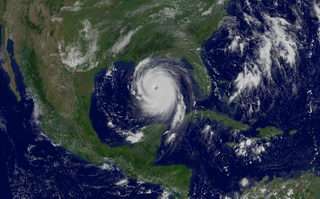Research Re-examines Strong Hurricane Studies

Researchers at the Georgia Institute of Technology have released a study supporting the findings of several studies last year linking an increase in the strength of hurricanes around the world to a global increase in sea surface temperature. The new study strengthens the link between the increase in hurricane intensity and the increase in tropical sea surface temperature.
It found that while factors such as wind shear do affect the intensity of individual storms or storm seasons, they don’t account for the global 35-year increase in the number of the most intense hurricanes. The study appears online in the March 16 edition of Science Express.
Last summer, the journals Nature and Science published studies claiming to show a very strong link between rising tropical sea surface temperatures and an increase in the strength of hurricanes. The Nature study, by Kerry Emanuel at the Massachusetts Institute of Technology, concluded that cyclonic storms in the North Atlantic and North Pacific oceanic basins were increasing in strength and duration. That increase, Emanuel concluded, was due to increasing sea surface temperatures caused, in part, by global warming.
A month later, the journal Science published research linking an increase in sea surface temperatures over the past 35 years to a near doubling in the number of the strongest hurricanes, those labeled Category 4 or 5. The study, authored by Peter Webster, Judith Curry and Hai-Ru Chang at Georgia Tech and Greg Holland at the National Center for Atmospheric Research, examined hurricanes in all oceanic basins that play host to cyclonic storms around the world.
This latest study sought to determine whether factors other than sea surface temperatures could be significantly contributing to this 35-year trend. Georgia Tech researchers Carlos Hoyos and Paula Agudelo, along with Curry and Webster examined three factors: vertical wind shear (changes in wind speed and direction with height); humidity in the lower atmosphere; and zonal stretching deformation, which is the tendency of the winds to rotate in a cyclonic direction.
“If you examine the intensification of a single storm, or even the statistics on intensification for a particular season, factors like wind shear can play an important role,” said Curry, professor and chair of the School of Earth and Atmospheric Sciences at Georgia Tech. “However, there is no global trend in wind shear or the other factors over the 35-year period.”
Curry said they did see a small but significant trend in increasing wind shear strength in the North Atlantic, but that the sea surface temperatures were the dominant influence on the increase in both global hurricane intensity as well as the intensity of the North Atlantic hurricanes.
“With this new paper, we firm up the link between the increase in sea surface temperatures and hurricane intensity, which has been a key issue in the debate about whether global warming is causing an increase in hurricane intensity,” said Curry.
Source: Georgia Institute of Technology



















